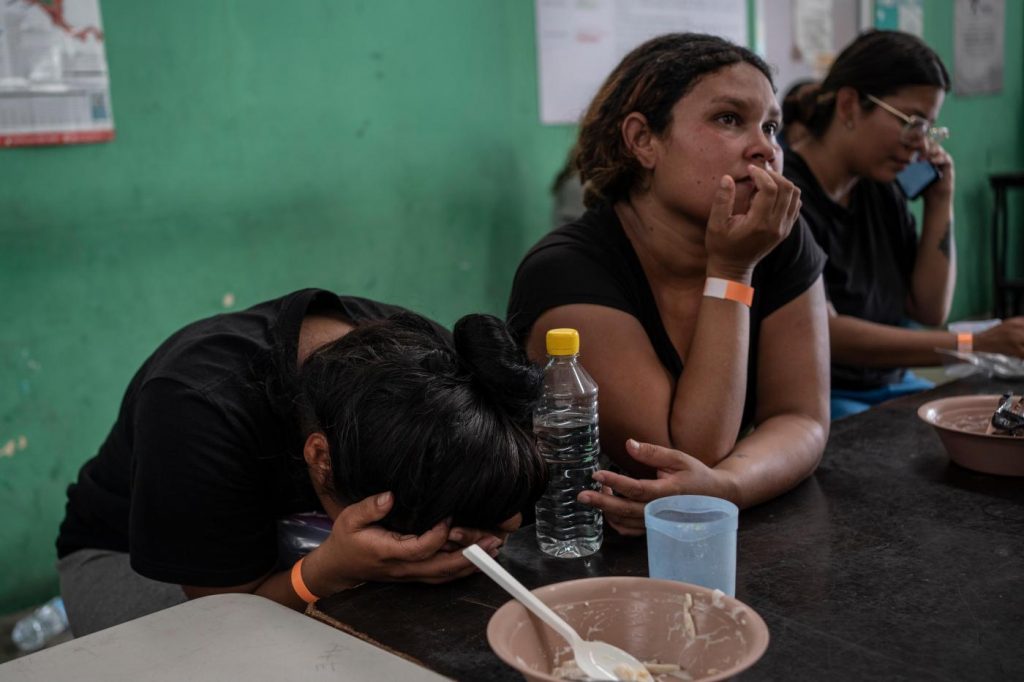By Megan Janetsky and Félix Márquez | Associated Press
VILLAHERMOSA, Mexico — “Here, again.”
Yeneska García’s face crumbled as she said it, and she pressed her head into her hands.
Since fleeing crisis in Venezuela in January, the 23-year-old had trekked through the Darien Gap jungle dividing Colombia and Panama, narrowly survived being kidnapped by a Mexican cartel and waited months for an asylum appointment with the United States that never came. She finally crossed the U.S.-Mexico border in May, only to have American authorities expel her.
Now she was back in southern Mexico, after Mexican immigration bused her to sweltering Villahermosa and dropped her on the street.
“I would rather cross the Darien Gap 10,000 times than cross Mexico,” García said, sitting in a migrant shelter.
She clutched a crinkled Ziploc bag that held her Venezuelan ID, an inhaler and an apple — her few remaining possessions.
Driven by mounting pressure from the U.S. to block millions of vulnerable people headed north, but lacking the funds to deport them, Mexican authorities are employing a simple but harsh tactic: wearing migrants out until they give up.
That means migrants are churning in limbo here as authorities round them up across the country and dump them in the southern Mexican cities of Villahermosa and Tapachula. Some have been punted back as many as six times.
Mexican President Andrés Manuel López Obrador said Monday that the policy protects migrants.
“We care a lot … about keeping migrants in the southeast because crossing to the north is very risky,” López Obrador said in his morning press briefing, responding to a question from The Associated Press about busing migrants to southern Mexico.
But the moves have forced migrants, including pregnant women and children, into even more precarious situations. That’s likely to worsen under President Joe Biden’s new asylum restrictions, analysts say.
Mexico’s actions explain a plunge in arrivals to the U.S.-Mexico border, which dropped 40% from an all-time high in December and persisted through the spring. That coincided with an increase in migrants in Mexico without legal permission, data from the country’s immigration agency shows. U.S. officials mostly credit Mexican vigilance around rail yards and highway checkpoints.
“Mexico is the wall,” said Josue Martínez, a psychologist at Villahermosa’s only migrant shelter, Peace Oasis of the Holy Spirit Amparito, which was bracing for a crush of people under Biden’s measure to halt asylum processing when U.S. officials deem that the southern border is overwhelmed.
The small shelter has been scrambling since Mexico’s government began pushing people back two years ago. Last month, it housed 528 people, up from 85 in May 2022.
“What will we do when even more people arrive?” Martínez said. “Every time the United States does something to reinforce the northern border, we automatically know tons of people are coming to Villahermosa.”
Migrants here walk or take buses north toward Mexico City, where they can request an appointment to seek asylum over U.S. Customs and Border Protection’s app, CBP One. But most never make it far enough north for the app’s location requirement.
Checkpoints dot southern Mexican highways. Armed soldiers pull migrants off buses and round up those walking along roads and in surrounding mountains. Of two dozen migrants interviewed by the AP, all said they were extorted by law enforcement or Mexican migration officials to continue on their journeys. After dishing out hefty sums two or three times, families had nothing. They were then bused back south, where most were left on the streets.
Mexican authorities refer to the temporary detentions as “humanitarian rescues.”
But Venezuelan Keilly Bolaños says there is nothing human about them. She and her four children have been sent to southern Mexico six times. The 25-year-old single mother wants asylum so her 4-year-old daughter can get treatment for leukemia, unavailable to her in Venezuela.
Days earlier, she was captured in the northern state of Chihuahua, where she said members of the military beat her in front of her crying children, then loaded them onto a bus for the two-day journey to Villahermosa.
“How can you run when you have four children? You can’t,” Bolaños said.
The family slept on cardboard boxes alongside other migrants outside Villahermosa’s bus terminal. Bruises still lined Bolaños’ legs. Yet she planned to take a seventh swing at heading north. She has nowhere else to go.
“I know that all this struggling will be worth it some day,” she added.
Mexico’s tactics appear to be a way to appease the U.S., which has pressured Latin American nations to help slow migration while failing to overhaul its own immigration system that most Americans agree is broken. Panama’s incoming president has promised to block passage through the Darien Gap, while Biden eased criticisms of El Salvador’s president after he reduced migration.
When Biden announced his new restrictions last week, he said he “drastically” cut migration to the border “due to the arrangement that I’ve reached with President (López) Obrador.” He said he also planned to work with incoming President Claudia Sheinbaum on border issues.
But Michael Shifter, a senior fellow at the Inter-American Dialogue, said such measures are only short-term solutions that don’t address root causes of migration.
“They say this is a regional challenge we all have to face together, which is true,” Shifter said. “The problem is: if the U.S. can’t get its own house in order, that sends a signal to other governments asking: ‘Why should we work with them if the U.S. itself is not capable of dealing with the issue?’”
Some asylum seekers said they were ready to give up on their “American dream,” but can’t leave because they’re cut off from their consulate or are out of money.
After being taken off of a bus, one group of migrants begged authorities to help them get back to Venezuela shortly before being sent back south.
“We just want to go to the embassy in Mexico City. To go back to Venezuela,” 30-year-old Fabiana Bellizar told officials, after being returned from northern Mexico a day earlier. “We don’t want to be here anymore.”
They started traveling the same route the next morning.
Others said they would try to find work and a place to sleep in the city before continuing on.
Related Articles
H-1B: Feds propose hefty fee hike on thousands of renewals for Silicon Valley’s favorite visa
Elon Musk, America’s richest immigrant, is angry about immigration. Can he influence the election?
Are more Americans moving to Canada because of Trump?
Will Biden’s new border measures be enough to change voters’ minds?
Biden rolls out asylum restrictions, months in the making, to help ‘gain control’ of the border
López Obrador on Monday said work is offered to migrants in the south, but the few lucky people face precarious conditions. One migrant was paid $25 a day for 12 hours of work under the beating sun on a mango farm. Another said employers tried to coerce her into sex work.
Others are forced to take more dangerous routes, and into the arms of mafias looking to kidnap migrants.
At the first sign of flashing lights, 27-year-old Honduran Alexander Amador dove behind a tree, scrambling for cover in the shadows cloaking the road between the Mexican states of Veracruz and Tabasco.
Amador and his two travel companions had been walking for 10 hours, running into the jungle to escape authorities trying to scoop them up along the highway. After being returned twice to southern Mexico while traveling by bus, it was the only thing the Hondurans could think of to continue onward.
But they were frightened, both of Mexican law enforcement and cartels. In the past year, security in southern Mexican states such as Tabasco and Chiapas has spiraled as cartels battle for control over lucrative migrant routes.
“Here, you can’t trust anyone. Everything is a danger to you,” Amador said, swinging his backpack over his shoulder and walking into the darkness.
Associated Press journalist María Verza in Mexico City contributed to this report.


